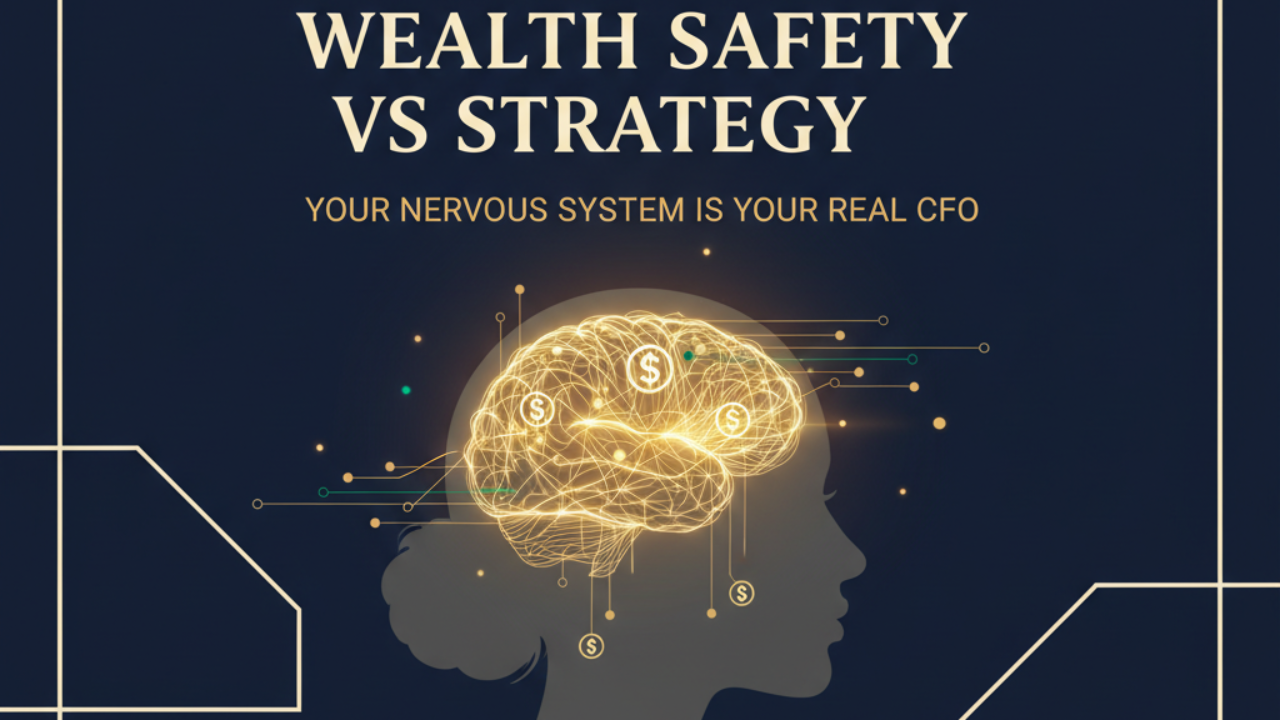
Episode 22: Wealth Safety vs. Wealth Strategy
Nov 18, 2025Why Your Nervous System Is Your Real CFO (And What To Do About It)
You've taken the courses. You're in the masterminds. You understand multiple income streams, active versus passive income, scaling versus stabilizing. You know the frameworks.
So why does your body still feel like it's standing on the edge of a cliff every time you make a money decision?
Here's what I've learned after years of coaching high-performing women: Most of you don't have a strategy problem. You have a nervous system that's still operating in "what if it all falls apart" mode.
And when your internal alarm system is running the show, even the best financial plan becomes a white-knuckle ride.
The Thing Nobody Wants to Admit
Let me paint a picture you might recognize:
You invest in a program you know is aligned—and then feel physically sick about the money.
You raise your prices—and then quietly discount, overgive, or add bonuses until your margins disappear.
You say you want passive income and freedom—then keep rebuilding offers and changing directions so you never actually land.
On paper, the strategy looks fine. In your nervous system, it feels like standing on the edge of a cliff.
This isn't just mindset. This is biology.
Your Brain on Money Stress
There's a whole body of research showing that when we're under stress, the part of the brain that handles long-term planning and thoughtful decision-making—the prefrontal cortex—actually goes offline. Meanwhile, the fear and threat centers like the amygdala get louder.
In plain language: the more activated your system is, the more reactive and short-term your money decisions become.
When I say your nervous system is your real CFO, I'm not being cute. Biologically, it's already in the driver's seat.
Researchers studying financial scarcity talk about something called "cognitive load"—the way money stress literally eats up mental bandwidth and reduces our ability to plan, focus, and solve problems.
You're not dramatic. You're not bad with money. Your brain is simply trying to function under pressure.
Wealth Safety vs. Wealth Strategy: What's the Difference?
Let me define this clearly, because it matters.
Wealth safety is not just having a certain number in savings, hitting a revenue milestone, or diversifying your investments. Those pieces can contribute to safety, but they're not the whole story.
Safety is the felt sense of:
-
I can hold what I have
-
I can handle what comes
-
I don't have to burn myself out to stay afloat
When your system doesn't feel safe with money, it shows up like this:
-
Hoarding cash and refusing to invest even when an opportunity is solid
-
Or the opposite: spending, investing, or giving money away as fast as it comes in
-
Overworking because you don't trust money to keep flowing
-
Taking misaligned clients because "it's money," even though it costs your sanity
Strategy, on the other hand, is how we direct energy. It's how you decide what offers you sell, how you structure your business or career, which markets you enter, which investments you choose.
But here's the truth: Strategy without safety is like driving a high-performance car with no brakes. It's fast, it's impressive, and it's one unexpected turn away from a crash.
On the flip side, safety without strategy can look like sitting on cash because you're afraid of making the wrong move, or staying in a job or business model you've outgrown because it's stable.
We need both. The goal is not to choose between them—it's to let strategy flow from safety, so your moves are anchored, not frantic.
Three Wealth Nervous System Types
As you read these, notice which one feels like home.
Type 1: The Over-Earner, Under-Receiver
You know how to hustle. You can push yourself into results. But the pattern looks like spikes of income followed by spikes of spending, over-investing in everyone else's priorities, saying "once I get ahead, I'll slow down"—and somehow never slowing down.
You're highly skilled at earning and deeply uncomfortable with having.
Type 2: The Financial Chameleon
Your money identity changes based on the room you're in. Around big earners, you feel behind and ramp up performance. Around people struggling, you minimize wins and dim your financial truth.
Your nervous system is constantly scanning: Where do I fit? Is it safe for me to be here?
Type 3: The Invisible Stabilizer
On the outside, you look very responsible with money. You plan, you save, you manage risk. But visibility with money—raising rates, sharing wins, stepping into a bigger stage—feels edgy or threatening.
Your wealth strategy revolves around staying safe by not being seen.
If you recognize yourself in one of these types, it doesn't mean you're broken. It means your system learned a particular way to survive. The work now is to teach it a new pattern.
The Three-Step Wealth Safety Check-In
Here's a simple framework you can use before making any money decision, big or small.
Step 1: Pause the Story, Feel the Body
Before you decide, pause for three slow breaths and ask yourself: Where do I feel this in my body?
Tight chest? Knot in your stomach? Buzzing, restless energy? Total numbness?
No judgment. Just information.
Step 2: Name the State
Check in with your internal threat dashboard:
-
Fight: "I have to make this work right now"
-
Flight: "Let's avoid this conversation entirely"
-
Freeze: "I don't know, I'll think about it later"
-
Fawn: "I'll just say yes so no one's disappointed"
Researchers studying anxiety and decision-making have shown that when you reduce psychological arousal—even briefly—you regain access to the higher-order thinking part of your brain. We're not just being woo here. We're doing brain maintenance.
Step 3: Choose from Regulation, Not Reaction
Give yourself 90 seconds. Breathe. Shake out your hands. Put both feet on the floor. Look at a point across the room and soften your gaze.
Then ask: "What would I choose if I already trusted myself with money?"
You might still decide the same thing. But your why shifts from fear to self-trust.
Your Reflection Practice This Week
I want you to pick one area—not all of them, just one:
-
Pricing
-
Saving
-
Investing
-
Spending
-
Giving
Now ask:
-
What does my body believe is safe here?
-
What does it believe is dangerous?
-
What is one micro-adjustment that would signal "we're safer now"?
Maybe it's creating a small emergency buffer. Maybe it's finally raising your rates. Maybe it's saying no to one misaligned ask. Maybe it's deciding "I don't chase clients, I invite them."
Choose one shift that feels meaningful but doable.
The Bottom Line
Wealth safety and wealth strategy are not separate worlds. They're two sides of every decision you make.
When your system feels safer, you don't need the perfect strategy. You become a better strategist—because you're not negotiating with panic in the background.
If this conversation is landing, if you're realizing you don't just need a better financial plan but a calmer internal operating system, this is exactly the work we do inside the 5-Day Wealth Activation.
We blend nervous system work, identity work, and strategy—so your next level of income doesn't require your next level of burnout.
Start the 5-Day Wealth Activation today
Lead with ease. Earn in alignment. And let your nervous system retire as your emergency-only CFO.
Listen to the Full Episode
🎧 Listen to Episode 22: Wealth Safety vs. Wealth Strategy on Unapologetically In Power
About the Author
Jennifer Damaskos is a leadership coach and real estate investor who helps high-performing women build wealth from self-trust instead of self-sacrifice. Through her brand Unapologetically In Power, she blends neuroscience, identity work, and strategic frameworks to create lasting transformation—not just temporary motivation.
Connect with Jennifer:
🌐 jennifer-damaskos.mykajabi.com
📸 Instagram: @unapologeticallyinpower
🎙️ Podcast: Unapologetically In Power
You’re not just here to listen. You’re here to rise.
This is your space to reconnect with the woman beneath the roles.
These companion notes aren’t fluff. They’re the fuel and the framework behind each episode—crafted to help you integrate the real talk, power prompts, and shifts you’re craving.
Because growth isn't a hack. It's a homecoming.

